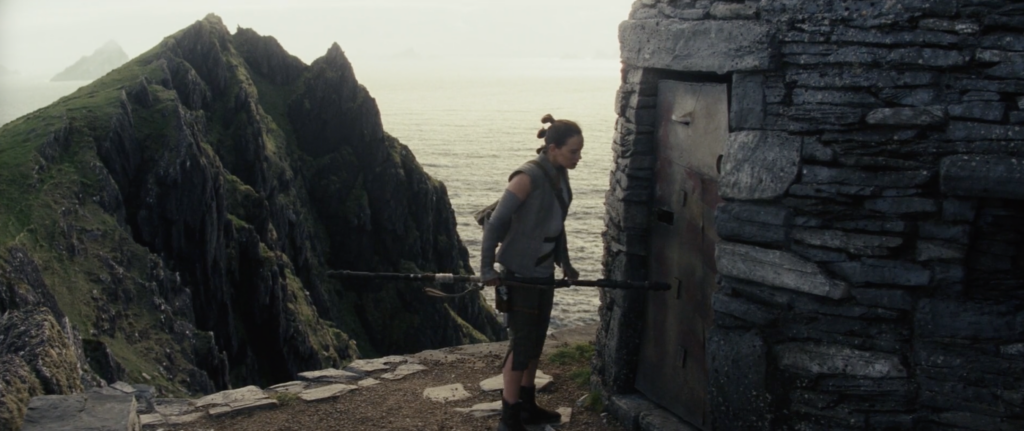The Last Jedi - Ceann Sibéal
Ceann Sibéal
|
Sybil Head
Address
An Baile Uachtarach Thoir, Dún Urlann, Corca Dhuibhne
52.183327
, -10.465522

This scene in the space opera The Last Jedi is set in the fictional planet of Ahch-To. Wide shots of the scene were filmed on Skellig Michael, but due to the archaeological and ecological sensitivity of the island, a replica of the settlement was created on Ceann Sibéal, on the mainland of Corca Dhuibhne, close to Baile an Fheirtéaraigh. For months, the headland was dominated by a temporary metal road and scaffolding towers, as artists and designers painstakingly recreated the stone huts and steps of the medieval monastery. Many locals were involved in production, between transport, security, safety supervision, and construction. In one famous incident, the alien creature Chewbacca made an appearance at the local primary school. Sacred Heart Student Eric Patrick Cameron made a documentary about the filming in West Kerry, which features interviews with locals, SHU in Dingle professors, and the director of the film Rian Johnson.
The filming of certain key scenes from the second installment in the last trilogy of Star Wars films to date, The Last Jedi, has resulted in a new burst of cinephile tourism to the west of Dingle, reminiscent of how Ryan’s Daughter brought Dingle into Hollywood’s sphere of influence.
For The Last Jedi, the beehive huts of Skellig Michael (previously the shooting location for Luke Skywalker’s remote home planet of Ahch-To) were recreated on the clifftop of Ceann Sibéal near Ballyferriter as a means of ensuring the delicate Skellig ecosystem and UNESCO heritage site would not be disturbed by further filming. The cliffs adjacent to Comuineol beach, directly under the most westerly point on mainland Ireland, Dún Mór, were also used for a scene in which Luke is seen milking a monstrous sea creature for its blue milk (evidently his favorite snack, as first seen in the original Star Wars: A New Hope from 1977).
For these latter shots, practical effects – including a huge puppet, transported via helicopter – were used, over the almost exclusive CGI (arguably over)used in previous installments like The Phantom Menace from 1999. This re-orientation towards practical effects and on-location shooting, integrated with CGI, help The Last Jedi alongside its sister films The Force Awakens and The Rise of Skywalker, achieve an immersively realistic effect towards the prolonged suspension of audiences’ disbelief.
Those who have seen the coastline of West Kerry will, of course, know immediately that the background seascapes of these shots have been CGI’d in such a way as to remove their geographical specificity (particularly through the editing-in of multiple rocks and islands) so that these scenes reflect more the sublime “feel” of a West Kerry landscape than they visually depict what really exists. Nor should they: we are in Ahch-To for these scenes, not Ireland, or any filmmaker’s, like David Lean’s or Ron Howard’s, vision/version of Ireland. This is fantasy owning fantasy.
Videos
Links
- » https://en.wikipedia.org/wiki/Star_Wars:_The_Last_Jedi
- » https://www.imdb.com/title/tt2527336/
- »https://www.independent.ie/entertainment/chewbacca-welcomed-at-irish-primary-school-with-stars-wars-theme-on-the-tin-whistle/34743592.html
- » https://en.wikipedia.org/wiki/Skellig_Michael
- » https://www.independent.ie/irish-news/exclusive-shots-show-set-of-new-star-wars-movie-being-built-in-kerry/34676455.html

